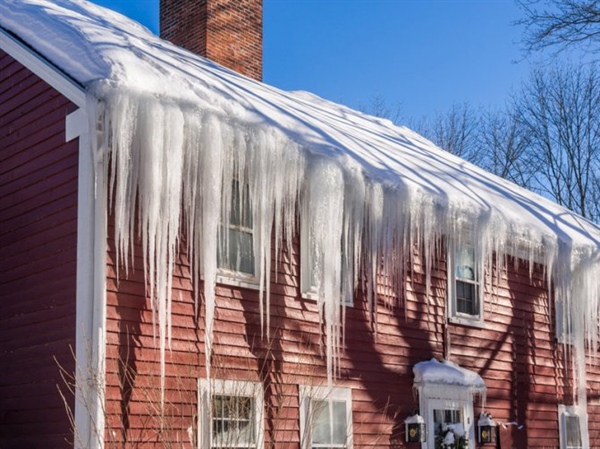5 Signs Your Roof Has an Ice Dam

There’s nothing quite like the magic of winter in the Twin Cities area, especially when the world is transformed into a glorious winter wonderland. But all of that lovely snow and ice can come with a price if your roof isn’t well-insulated. As the heat from your home begins to melt the snow on your roof, water travels to the roof edge, where it refreezes.
After an extended period, it will begin to form a natural barrier of ice known as an ice dam. Since ice dams prevent water from draining from your roof, it has nowhere to go, causing it to move into your roof’s underlayment and seep into your home.
In this post from the water damage restoration services at Restoration Network, we’re breaking down the most common signs your roof has an ice dam and describing what to do when you have an ice dam. When you need water damage removal, give us a call at 612-564-0202.
1. Visible Ice
Although you won’t always be able to spy an ice dam from the ground, you can usually see some indication that you’ve got ice dams if you take a walk around your home when the roof is covered with snow.
If you’ve got icicles hanging from your roof, there’s a good chance they’re connected to ice dams somewhere on top of your roof.
2. Damaged Gutters
When ice dams grow, they tend to push against your gutters, forcing them out and away from the roof. When this happens, gutters can become warped, bent, rusted, and even broken.
If it looks like your gutters are pulling away from your roof, you may have issues with ice dams.
3. Damaged Shingles
Ice dams cause a very specific type of shingle damage that can usually be identified with a roof inspection. When the water from an ice dam seeps under the shingles and into the underlayment, it can refreeze.
When this happens, it expands, popping or lifting the shingles from the roof. This leads to a cumulative damage feedback loop that allows more and more water to get into your home.
4. Water Damage
As water leaks into your home through your damaged roof, it will get into your attic, where it can wreak havoc on your insulation. But that’s just the beginning. Over time, it will begin to weaken your roof and warp and rot the structure of your attic and walls.
Water will also seep into your ceilings, causing ceiling and wall damage every time it rains. And over time, mold will begin to form, further damaging the materials and threatening the health of your home’s occupants.
5. Snow Melting Only On the Top of Your Roof
If you have noticed that snow only melts on the top of your roof and not towards the edge, your roof may have an ice dam. Seeing that ice dams form when a rim of ice forms around the edge of your roof, it only makes sense that snow would pile up above it toward the bottom of your roof.
Your ice dam also grows larger when snow from the top of your roof melts, falls down as water, gets trapped because of the existing ice, and refreezes on top of the ice dam, so act early and get professional help.
How to Prevent an Ice Dam from Forming
Ice dams form when your roof is not heated consistently, so take steps to fix that. The majority of your roof's heating comes from your home, regardless of whether you have a heated attic or not, because hot air rises and is naturally drawn to cold air, especially if your roof insulation is poor or inconsistent.
The sun also heats your roof, even in the winter!
Close Attic Bypasses
Preventing heat from escaping certain sections of your roof should be a priority when preventing ice dams. Close up gaps in your drywall, cracks in your roof, and spaces around plumbing pipes, chimneys, and access hatches.
Install Insulation
If you already have roof insulation and think that’s good enough, think again. Insulation has different quality levels and should be made up of different materials and be of a greater thickness in your ceiling and roof.
Some insulation even makes your roof colder, which may be the issue. Installing insulation is difficult to do alone if you want to account for the shape of your roof, chimneys, and access ways, so get professional help.
Handling It Manually
Chipping at an ice dam on or near your roof is a safety hazard, but there are ways to start dealing with it manually. The first of which is to use a rake or long object to clear snow from above the ice dam, so it doesn’t melt the snow, causing the ice dam to grow in size.
The second of which is to set up a box fan to blow air and gradually melt the ice dam.
Use an Ice Dam Prevention Product
There are actually many products available for purchase online and in-person that help prevent ice dams. The most common of which is a roof heating cable, but ice & water shields and metal panels can also be helpful depending on the type of roof.
When you get roof maintenance for the winter, make sure to ask ahead of time to get professionals to set up and install the best option for you.
Twin Cities Water Damage Restoration Services
When you’ve got water damage from ice dams, you need it gone fast to stay safe. That’s when it’s time to call Restoration Network, your Twin Cities source for water damage restoration services.
Give us a call at 612-564-0202 or contact us online for help when you need us, and we’ll help you take back your home from ice dams.